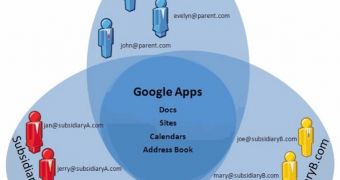Google Apps has now introduced support for multiple domains with the same account. It enables businesses, especially large organizations that are more likely to have this problem, to manage user accounts for employees using different domain names for email addresses and the likes. Until now, there has been no simple way of doing that, you either had to have domain aliases set up for each additional domain or use different Google Apps accounts.
“Now there’s a better way: multi-domain support in Google Apps. Multi-domain support is a new admin control that allows organizations with two or more domains on Google Apps to manage them from a single control panel. Users belonging to different domains within an organization keep their domain-specific email address but can see coworkers from other domains in the organization’s global address book,” Will Smit, software engineer at Google Apps, announced.
One major hurdle that this new feature overcomes is collaboration between various groups within the same company. Coworkers can share and collaborate on documents and files regardless of what department they’re from and without compromising the internal security. The added flexibility should be useful in several cases, but it comes especially handy for large corporations using several domains.
Google exemplifies with the Brady Corporation, which has 88 different domains. Any other workaround would have been nearly impossible and not worth the effort at this scale. Setting up domain name aliases for 88 sites is impractical to say the least. And having different Google Apps accounts meant that all the departments would be cut off from each other, negating the benefits of using a cloud-based platform focused on sharing like Google Apps.
The new feature is now available to Premier and Education users free of charge. Zoho, one of Google Apps’ competitors, already had multiple domain support. Microsoft Exchange, the giant in the market, also supported the feature, so it was only natural for Google to offer it.

 14 DAY TRIAL //
14 DAY TRIAL //